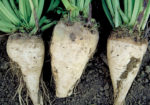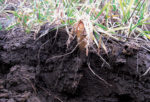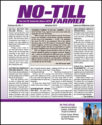Advertise Follow Us
No-Till Farmer

View Archived Issues
January 2015
Volume: 44
Edition: 1
Get full access NOW to the most comprehensive, powerful and easy-to-use online resource for no-tillage practices. Just one good idea will pay for your subscription hundreds of times over.
-
Table of Contents
Table of Contents
Digital Subscribers enjoy full access to No-Till Farmer's premium content. A paid subscription is required in order to read these stories.Are you a Premium or Digital subscriber? You enjoy:
- Unlimited access to all digital content here
- Freedom to view No-Till Farmer on all your devices
- Gleaning years of knowledge from the world's largest online library dedicated to no-till practices
Are you a Print only subscriber? Easily upgrade your subscription today! For only $10 more on a one year option, you gain the benefits of both the print edition delivered to your door and unlimited access to thousands of online pages of no-till content.
Less Iron, More Cover Tames Tough Plains Soils
Brian and Alan Johnson turned to no-till, cover-crop cocktails and CRP to reclaim saline seeps and improve productivity in tough growing conditions.Read MoreEasing into No-Till, Cover Crops Holds Hilly Soils, Reduces Weeds
A growing dairy operation prompted a Wisconsin farm to adopt more conservation practices, giving them healthier, mellower soil and better use of time and labor while maintaining yields.Read MoreNo-Till NotesNitrogen on Soybeans: To Use or Not to Use
No-tillers wanting to break a yield plateau with soybeans should study the nitrogen cycle and identify environments where additional applications makes sense.Read MoreWhat I've Learned from No-TillingBreaking Through the No-Till Barrier with Cover Crops
Adding winter wheat, livestock and cover crops helped Paul Ackley overcome his no-till plateau, simplify his planter and build more productive soils.Read MoreSugarbeets Could Be New Cover for Forage, Tough Environments
Northern no-tillers looking for a cover crop that will winterkill, produce high-quality forage and work in tougher soils may want to consider this traditional cash crop.Read MoreBuild Up Your No-Till Soils and Earthworms Will Come
Reducing tillage, adopting controlled traffic, seeding cover crops and improving drainage can help no-tillers build populations of these nutrient-laden subterranean creatures.Read MoreProper Soil pH is Key to Molybdenum Availability
Most problematic for legumes, molybdenum deficiencies are sometimes misdiagnosed as nitrogen deficiencies, but with a soil pH greater than 6.0, a response to applications is unlikely.Read More -
Featured Articles
Featured Articles
Less Iron, More Cover Tames Tough Plains Soils
Brian and Alan Johnson turned to no-till, cover-crop cocktails and CRP to reclaim saline seeps and improve productivity in tough growing conditions.Read MoreProper Soil pH is Key to Molybdenum Availability
Most problematic for legumes, molybdenum deficiencies are sometimes misdiagnosed as nitrogen deficiencies, but with a soil pH greater than 6.0, a response to applications is unlikely.Read More - Digital Edition











